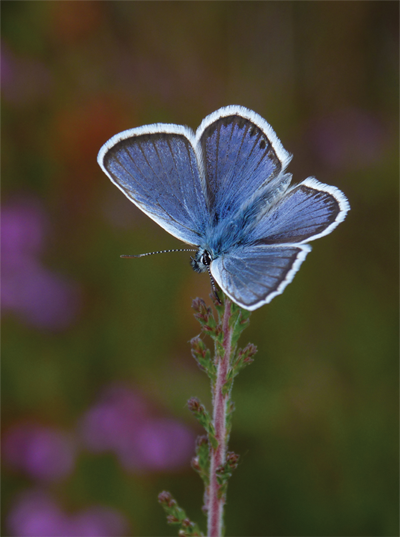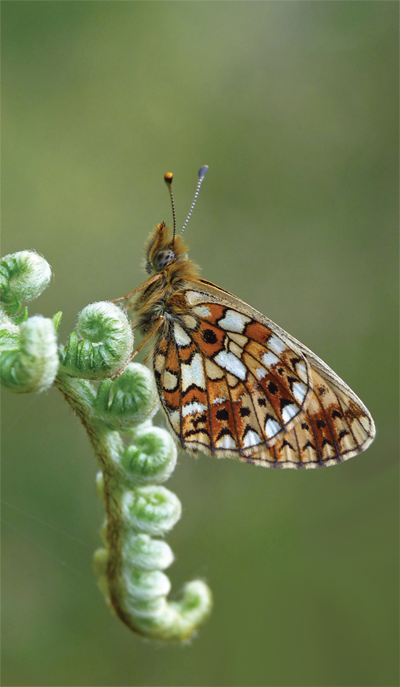Butterfly Photography - Guidelines and Tips
Originally published in the Spring 2011 Sussex Butterfly Report
 Time to get up
Time to get upSilver Studded Blue photographed at 7.45am
The photography of butterflies has in many ways replaced the outdated pursuit of collecting, by fulfilling the urge that many of us feel to 'capture' their beauty for posterity. However, an equal or greater number will prefer just to retain the encounter as a memory and we must always take this into consideration when going about our business. As another season approaches I would like to highlight a few points of 'etiquette', both for the benefit of other butterfly-watchers and, in some cases, for the insects themselves. I'll then move on to provide some tips which will hopefully improve your chances of getting an image to be proud of.
Each year we run a full calendar of field trips and these will be attended by those both with, and without, a camera in hand. The primary aim of these outings is to ensure that everyone manages to get a good, close-up view of the butterflies; photography is of a lower priority and of only secondary importance at our events. Please ensure that all attendees have managed to get a good 'look-in' before attempting a few shots. Remember that we are all different and some people might be less inclined than others to ensure that they are at the front of a sometimes large group of enthusiasts. When you are satisfied that everyone has managed to get a good view of the butterfly (which might be their first experience of that species), then move in briefly to fire off some frames. There will always be time to come back after the official end of the walk and some outing leaders (particularly keen photographers like me) will often linger afterwards to help relocate the butterflies.
After no more than a couple of minutes to allow for photography, it will be time to move on. Bearing in mind that many of the participants, including some event leaders, will be interested only in watching the insects, it is important that the 'slowest ship in the convoy' does not significantly hold up the progress of the party. These days we must observe health & safety guidelines and exercise our duty of care, so it is important to recognise the contribution being made by your guide, and assist him/her in making the job a little easier by keeping the group together. As I shall go on to explain, this is not the ideal time to achieve the best results with a camera; field trips are run at a time of day to ensure we see the butterflies 'in action', when photography is often at its most difficult. You can always return at a later date to achieve that once-in-a-lifetime shot. Keen photographers should really view the organised events as a reconnaissance trip, to learn more about your quarry and where it can be located.
Golden Rule
The welfare of the butterfly comes first!
There are also some other things to bear in mind when taking photographs. The 'golden rule' is that the welfare of the butterfly (which in the case of rarities might translate to the welfare of the species) must come first. Always be aware of where your feet are ending up! Some of the most desirable subjects are declining or even threatened species, with small and vulnerable colonies being dependent upon sometimes tiny areas of habitat and a low number of individual food plants. Trampling can become a real issue in these cases.
It is also important to let the butterflies go about the more important aspects of their daily business unhindered, with the acts of procreation and egg-laying being at the top of the list. Common sense and experience will tell you when it is time to back-off, but always take extra care while approaching them in these circumstances. Move in with even greater stealth than you normally would, bearing in mind that this is the next generation of butterflies in-the-making.
 Time for bed
Time for bedSmall Pearl Bordered Fritillary photographed at 7.45pm
Moving from 'don'ts' to 'dos', how do you get that perfect picture? For starters, you don't need an expensive top-of-the-range DSLR camera; although it is nice if you can afford one, and it will certainly produce the best results for most subject matter. However, excellent butterfly images can be captured using a good compact or bridge camera. It's what you do with it that counts and field craft is undoubtedly the key to success. By gaining a thorough understanding of their behaviour, you will be rewarded both by the increased knowledge you accumulate and the ability to capture the sort of images you aspire to. As you begin to unravel the factors that influence their behaviour patterns and daily routines, the entire process of photography becomes both easier and more satisfying. That said, species such as the Wall Brown will always have you tearing your hair out!
Don't chase butterflies around in the heat of the day. You will only end up frustrating yourself and possibly interfering with important aspects of their life-cycle. The clever photographer will always be out early, when the insects are yet to fully warm up and are partial to a breakfast of nectar, or late, as they start to settle down ready to roost. Be patient and let the insects come to you, by noting where they regularly return to a favoured perch or flower.
My favourite time for photography is a summer's evening and I will often delay heading out until 7pm if the day has been hot and sunny. As the butterflies congregate in readiness for the cool night ahead they will often bask with their wings wide open, catching the last heat of the sun's rays. In this state they are often quite approachable. As the sun finally sinks below the horizon the wings will suddenly snap shut. Butterflies don't suffer from insomnia. I always enjoy watching Grizzled Skippers collecting at a communal roost, and close observation reveals that their tiny antennae will soon start to droop as they enter the 'Land of Nod'. With light levels still good enough, the butterfly is now fully prepared for a photo-shoot, even giving you time to set up a tripod if you so wish. Of course once you know the location where butterflies habitually roost, an early morning trip to watch them wake up can be equally rewarding.
If you are out in the middle of the day in the hope of getting some good photographs, choose your day carefully. Days with partial cloud-cover are best and even the incessantly wandering Orange Tip will suddenly put down to rest when the cloud obscures the sun and the temperature drops. Watch and wait for the reappearance of the sun, and be ready for those beautiful wings to slowly open.
If the Peacock or Brimstone is your target, wait until the fresh specimens emerge later in the summer. They will have only one thing in mind - nectaring to build up reserves in readiness for a winter in hibernation, making them relatively easy to photograph. However, when they reappear in the spring, their minds will be entirely occupied by the opposite sex; they are much more difficult to approach at this time of year.
If it's the Purple Emperor you wish to 'capture' for posterity, you need to be out on a sunny morning in the last few days of June or first two weeks of July, and the earlier during this period the better. I appreciate how exciting it is to see a male Purple Emperor descending to the woodland ride for the first time, and every single time thereafter, but you must control that excitement, or go home disappointed. You must wait until he has landed and fully settled in one spot. Resist the urge to approach until he has stopped wandering around in search of salty delicacies, which might involve several short 'hops' along the ride and further meanderings on foot. Finally, check with binoculars that his long, yellow proboscis has stopped probing around, before finally moving in - very slowly. Every season I see a dozen Emperors spooked by photographers that 'give in' to the adrenalin-rush and make a premature and clumsy approach. Your patience will be rewarded, for once he has fully settled down to feed he will behave impeccably!
Top Tips for Photographers
On field trips:
- let everyone see the butterfly before moving in to take photos
- keep up with the group
- treat the experience as a reconnaissance exercise
At other times:
- respect fragile habitat (no trampling!)
- respect the butterfly life cycle
- choose your time of day
- take it slowly, and
- have patience!
The wider issue of stealth is a key element in all butterfly photography. Butterflies are not scared of people, but they are scared by sudden movements and looming shadows, which spell danger. Exponents of Tai Chi will make the best butterfly photographers; the achievement of success and happiness is all about very slow, controlled and smooth movements of both body and camera.
With the season nearly upon us many will be re-charging camera batteries and dusting off their lenses. I hope you will enjoy another summer of happy snapping, but please do remember to keep other enthusiasts and the welfare of the butterflies in mind - and watch where you put those feet!


